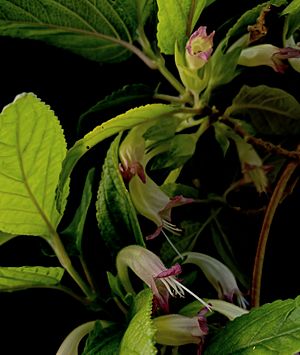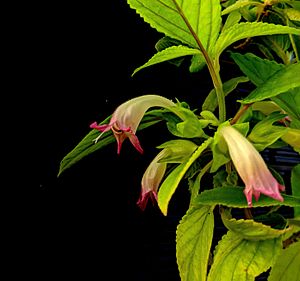Oahu stenogyne facts for kids
Quick facts for kids Oahu stenogyne |
|
|---|---|
 |
|
| Conservation status | |
| Scientific classification | |
| Genus: |
Stenogyne
|
| Species: |
kanehoana
|
The Oahu stenogyne (scientific name: Stenogyne kanehoana) is a very rare flowering plant. It belongs to the mint family. This special plant is found only in Hawaii. It grows specifically in the Waianae Mountains on the island of Oahu. Because it is so rare, the United States government has listed it as an endangered species. This means it is at high risk of disappearing forever.
Contents
About the Oahu Stenogyne
The Oahu stenogyne is a unique plant. It is a type of vine that can grow to be 1 or 2 meters long. Its stems and leaves are covered in soft, woolly hairs. This plant is known for its interesting flowers.
What Does It Look Like?
The leaves of the Oahu stenogyne can grow quite large. They can be up to 14 centimeters long and almost 5 centimeters wide. The plant produces tube-shaped flowers. These flowers can be over 4 centimeters long. They are usually white or yellowish. The tips of the flowers have a pretty purple-pink color.
How Does It Reproduce?
This Hawaiian mint has a special way of making new plants. It uses something called vegetative reproduction. This means it can grow new plants from its stems. When a stem touches the ground, it can grow roots. These roots then form a new plant. This new plant is a perfect copy, or clone, of the original plant.
Why Is It Endangered?
The Oahu stenogyne is one of the rarest plants in the world. For a while, people thought it had completely disappeared. The last known plants died in 1996. This was very sad news.
Efforts to Save It
Luckily, in the year 2000, six more plants were found. But by 2005, these plants also died. As of 2004, only one very large plant was left in the wild. This single plant was over four meters long. It might even have been several plants growing very close together. Scientists have taken small pieces, called cuttings, from this plant. They are trying to grow new plants from these cuttings. This helps to protect the species from becoming extinct.



